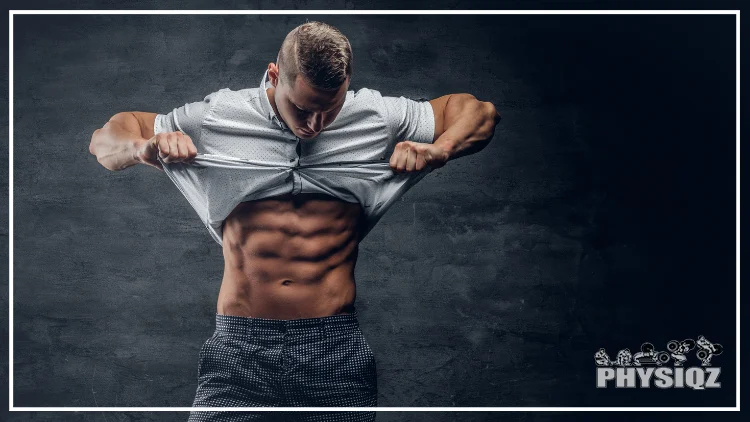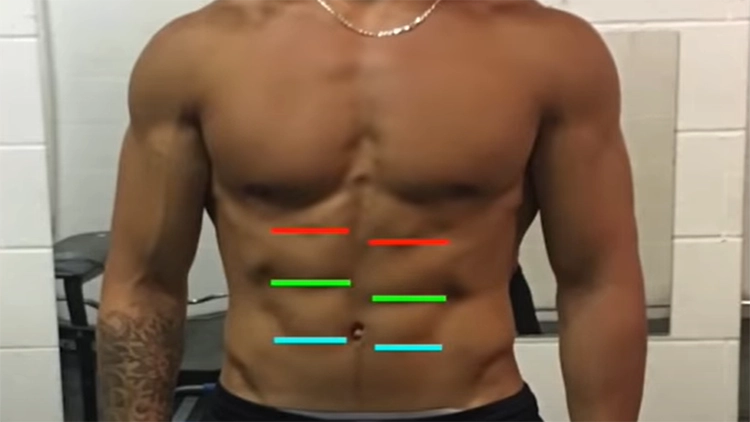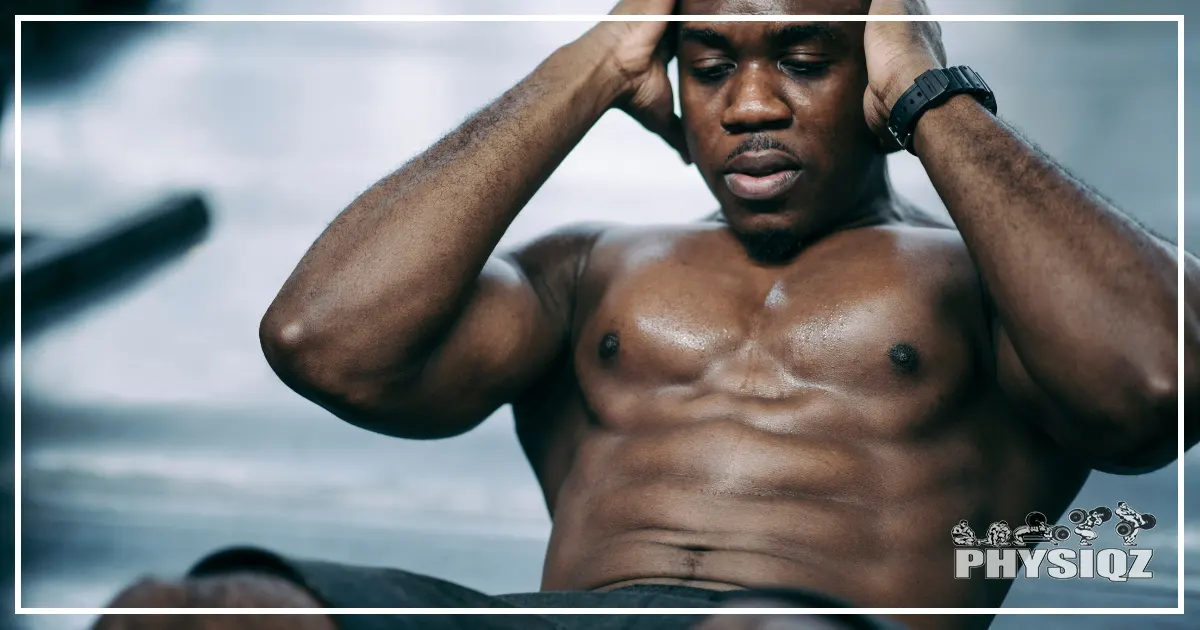
Bad ab genetics can be defined in countless ways and a two-pack or one-pack belly can be frustrating to deal with.1It might be your genetics, or it could be influenced by other factors such as body fat percentage, imbalances, or training methods.
The truth is, genetics have a significant role to play in whether you will have great abs, but making the simple mistake of not following through with an effective training plan and not performing enough volume will prevent you from realizing the abs that superstars and athletes are famous for. Examine whether poor abdominal genetics are affecting you and discover how to correct them by avoiding this common mistake.
Below we’ll cover what exactly bad ab genetic means (amount of abs, symmetry, insertion points, etc.), how bad and good ab genetics look like, and the best ab exercises to get a six pack.
What’s Considered Bad Ab Genetics?
Several factors are the culprit of bad abdominal genetics, but a brief understanding of the anatomy of the abdominal muscles is needed before analyzing these.2
As many know, the abdominal muscles are situated between the ribs and pelvis, and their primary function is to support the trunk, enable movement and support the organs by maintaining internal abdominal pressure.3
What’s lesser known is that they are composed of pyramidal, transversus abdominis, rectus abdominis, external oblique, and internal oblique muscles.4
There are several factors that play into having poor ab genetics and are discussed below.
The Amount of Abs
Depending on an individual’s genetics, the bands that form the muscles of the abdominals will vary. Those with bad abdominal genetics will have a lower number of defined abs resulting in either 4, 6 or rarely 8-pack or even 10-pack abs.
The rectus abdominis is the primary muscle that gives the ‘blocky’ looks of the abs and is not divided into upper, middle, or lower abs—that gives the impression of segmented abs.
The reason it appears this way is that it is divided up by bands of connective tissue. These tissues are pulled tighter in some areas than in the rest, giving the appearance of divisions of specific muscles— it is all one muscle.
For a good chunk of the population, three intersections run down the rectus abdominis.5
A small section of the population will have genes to give them the ability to have 8-pack abs—8 packs abs are genetic. It is possible to have 10-pack abs—individuals that genetically inherit a characteristic of having 5 bands of connective tissue will display a 10-pack ab.
Insertion Points
The insertion points of the abs are how the rectus abdominis muscle inserts into the ribs. The insertion points, if not regular, will give the appearance of asymmetry or being uneven and not lined up.
There are a number of individuals that will have narrow abs due to poor ab genetics. This is a result of a lot of room between the edge of their ribs and outside the abs—there is simply not enough muscle covering this room, which limits the size the abs can grow to, thus preventing them from having decent-sized abs.
Overall, insertion points can effects abs and even be an indicator of bad shoulder genetics too.
Fat Locations
Sometimes individuals may have less aesthetically pleasing abs due to the distribution of fat cells around the abs.
There may be uneven fat around the abs particularly above the rectus abdominis—more in other areas than others which will give the impression of bad six-pack genetics. Also, the less fat there is around the abs, the more visible they are.
Asymmetry or Uneven Abs
Uneven abs are caused by having bad ab genes and/or having muscular imbalances. In this case, the abs are weaker in some areas than others. Oftentimes, uneven abs are simply a result of genes inherited since birth or abs being weaker in some areas more than others.
The rectus abdominis is usually the same size on both sides—however, the segments don’t line up—which gives the impression of lacking symmetry and looking uneven. Ideal-looking abs are meant to appear symmetrical and very even.
However, this shouldn’t cause too much worry, as many bodybuilders and professional athletes have uneven abs which go to say, it’s quite common.
How to Check if You Have Bad Ab Genetics vs Good Ab Genetics
There are several ways to check if you have bad abdominal genetics or determine if you have good ab genetics by observing some physical descriptors.
Consider the following signs to point to good or bad abdominal genetics:
- The number and shape of abs can usually be seen if someone is under a certain body fat percentage. The amount of abs a person has is a huge determination of the population’s argument on what counts as bad abdominal genetics vs good ab genetics, and some may view 4-pack abs as genetically inferior since the idealized number is either 6 or 8-pack abs.
- Visibility and fat presence of the abs is difficult to quantify but when lean enough, lifters can compare the fat deposits on their abs and other body parts against their counterparts who are under 15-20% body fat.6 The best way to tell if someone holds more fat in their abdomen region is through a DEXA scan or something similar.
- Insertion points those with bad abdominal genetics may have peculiar insertion points that will give an irregular appearance to the abs with minimal aesthetic appeal. They will usually appear too narrow for the person’s midsection.
- Asymmetrical and uneven abs are apparent by an untrained eye due to the bands of connective tissues. They will essentially look misaligned or crooked.
What Do Bad Abdominal Genetics Look Like?
Bad abdominal genetics generally have a lesser aesthetic appeal and when someone mulls over good abs, an image of 6-8 ‘blocky’, decent-sized abs comes to mind. They will be of significant size, striated, regular, chisel-shaped, and very pronounced which goes to say, bad abdominal genetics will look quite the opposite.
2-4 Pack Abs
The ideal number of abs—six, eight, or ten will largely depend on the number of connective tissues that make segments of the bands of the rectus abdominis— which is down to genetics. Those with fewer connective tissues that cause these ‘divisions’ will simply not have the ability to have a higher number of abs.

Notice how only two abs are visible while he is flexing in front view and side view. Source: Hypertroph on Youtube7
Thus, if someone has 3 connective tissues yielding 6-pack abs, they will not ever have 8 or 10-pack abs. Arnold Schwarzenegger— the poster child for bodybuilding has 4-pack ab genetics which some may view as bad abdominal genetics.
Non-Visible Abs Due to Fat Being Held in the Abdomen
At a lean body mass, abs that have little visibility and are not pronounced usually result from fat being held in the abdominal section. Heck, some people even store more fat in their butts, biceps, face, and more but it’s more noticeable when it comes to abs.

See how his abs are barely visible due to the fat over it. Source: Jeremy Ethier on Youtube8
Small or Oddly Shaped Abs Due to Insertion Points & Bad Abdominal Genetics
When abs are small in size or oddly shaped, i.e., they don’t have a ‘blocky’ appearance or are also relatively small, this is due to poor ab genetics. Notice on the individual below, that he’s very lean and muscular, but his abs are narrow in comparison to his torso.

It’s apparent how his abs are oddly narrow compared to the width of his stomach due to his insertion points. Source: @jaylisacek on Instagram9
Crooked, Asymmetrical, & Uneven Abs
When abs are uneven or irregular, they just look lopsided and while still great if they show, may be slightly less pleasing to the eye than perfectly straight abs.

It’s noticeable here how his abs are uneven and looking lopsided as indicated by the red, green and blue lines. Source: Jeremy Ethier on Youtube8
These abs are also known as staggered abs. Crooked or irregular abs are due to insertion points and nothing can be done to alter their shapes. The only thing to do is achieve growth and increase their size, but the shape will remain the same.
Exercises to Overcome Bad Abdominal Genetics
While genetics play a big part, there are several exercises that can be done to overcome bad genetics. After checking and confirming that you have bad abdominal genetics, embark on the below exercises to overcome even the worst ab genetics ever.
Hanging Knee Raise
This exercise is done by hanging on a bar and raising the knees to the chest. This should be done by curling and arching them forward—they should not just be brought straight up.
Hanging Straight Leg Raise
This exercise is performed by hanging on a bar and raising the entire leg. The leg does not need to be entirely straight; just as much as is possible and kicking them as high as possible. The movement should be controlled on the way down.
Machine Crunch
This is performed using a crunch machine of which there are variations. The exercise should be completed using a full range of motion and should always be a slow controlled movement.
Modified Candlestick
This should be accomplished by laying on a flat bench with hands holding the bench just below the head. Raise the legs up by bending the knees and straightening them at the top. On the way down, the legs need to be straight, and the torso should remain rigid.
Reaching Sit Up
Lay down on the floor and ensure the feet are held to prevent movement and provide a hinge. Lift the entire torso up and hands may be raised while doing so, and return to the starting position.
Rope Crunch
To perform this exercise, kneel with your back facing the cable pulley machine. Grip triceps rope around the neck and hands should be close to the mouth area, then bend down to achieve contraction. Ensure the spine is being flexed and not hips alone.
Slant Board Sit Up
This exercise is done on a declined bench with a lightweight in hand and up against the chest. The feet are also held down; there are dedicated benches for this exercise. Proceed to go down and then curl upwards until perpendicular to the ground.

Source: mihailomilovanovic via Canva.com10
V-Up
This is performed on the floor while laying against the back while holding a light weight with both hands. Arms and legs need to be placed as straight as possible, then touched down, then touch the weight to the feet.
How to Fix Poor Ab Genetics Through Adequate Volume & Volume Landmarks
Bad abdominal genetics is out of an individual’s control and the same lies true for bad chest genetics; however, by incorporating the said exercises through volume landmarks, anyone can get a toned body with a strong core and great-looking abdominal muscles.
Volume landmarks to be adhered to in this case will be:
- MEV (Minimum Effective Volume)—the amount of volume that goes into a workout that is key to achieving muscle hypertrophy (growth).
- MRV (Max Recoverable Volume)—when muscle groups are worked out, they require a recovery before being hit again. This creates a cycle. MRV is the maximum volume of work-outs between these cycles.
Training abs can be performed at MEV during every session, which usually leads to soreness. When the soreness is gone, someone will need to push themselves harder than they did the time before.
If more time is required in order to recover, like an extra day, then this should be done. For the most part, most individuals can train abs 3-6 times a week.
The key is volume to ensure the muscle is stimulated enough to achieve hypertrophy.
It should be noted that the abs provide a platform for other compound exercises such as squats, deadlifts, and standing overhead presses.
Therefore, volume increases should be done in small increments so as not to compromise these other exercises. Alternating between the different exercises during different training sessions may also be beneficial.
When a training session is between MEV and MRV volumes, fatigue will abate in about 1-2 days. The next session can then be trained with a level where performance as before or even improved.11
Therefore, it would be prudent to take note of these two concepts to overcome poor ab genetics while increasing training frequency and volume. Ensuring a muscle-mind connection is crucial to ensuring effective and balanced growth when training abs.
Those with poor ab genes should not be discouraged, as can be seen in examples such as Dwayne “The Rock” Johnson, a former wrestler turned actor—Dwayne has poor ab genetics but has still been able to grow and tone his abs through hard work. Arnold Schwarzenegger, pictured earlier, may be considered to have bad abdominal genetics since he only has 4 abs, but that has not prevented him from being a 5-time Mr. Universe and 7-time Mr. Olympia winner.
While it is always a good idea to check if you have bad ab genetics and that bad ab genes play a significant role, this should not prevent anyone from achieving superstar-like abs through following consistent, well-planned training regimens and maintaining healthy lifestyles.
References
1Popalvsky, Andrew. “Young Athletic Male Shows Six Pack Abs.” Canva. Accessed 7 April 2023. <https://www.canva.com/photos/MACO-BhT2rE-young-athletic-male-shows-six-pack-abs/>
2Medicine, N. L. (2021, July 31). Anatomy, Anterolateral Abdominal Wall Muscles. Retrieved 2022, from www.ncbi.nlm.nih.gov: <https://www.ncbi.nlm.nih.gov/books/NBK470334/>
3Medicine, N. L. (2021, July 31). Anatomy, Abdomen and Pelvis, Abdominal Wall. Retrieved 2022, from www.ncbi.nlm.nih.gov: <https://www.ncbi.nlm.nih.gov/books/NBK551649/>
4Channel, B. H. (2022). Abdominal muscles. Retrieved 2022, from www.betterhealth.vic.gov.au: <https://www.betterhealth.vic.gov.au/health/conditionsandtreatments/abdominal-muscles>
5Medicine, N. L. (2015, June 1). Variation in Tendinous Intersections of Rectus Abdominis Muscle in North Indian Population with Clinical Implications. Retrieved 2022, from <https://www.ncbi.nlm.nih.gov/pmc/articles/PMC4525496/>
6Healthline. (2022). Body Fat Percentage for Abs: What’s the Magic Number? Retrieved 2022, from www.healthline.com: <https://www.healthline.com/health/body-fat-percentage-for-abs#male-percentages>
7How many WEEKS will it take to get SIX PACK Abs (EXACT FORMULA).” YouTube, 2 January 2021. Accessed 30 March 2023. <https://www.youtube.com/watch?v=NRl9uKhnEJ0>
8Uneven Abs: The 3 Main Types and How to Tell Which One You Have.” YouTube, 13 December 2011. Accessed 30 March 2023. <https://www.youtube.com/watch?v=joq7bWHGsSk&t>
9JAY LISACEK (@jaylisacek) • Instagram photos and videos.” Instagram. Accessed 30 March 2023. <https://www.instagram.com/jaylisacek/>
10mihailomilovanovic. “Abs workout.” Canva. Accessed 7 April 2023. <https://www.canva.com/photos/MAEJMLU8mw4-abs-workout/>
11sraetel, D. M. (2019, December 16). AB (ABS) GROWTH TRAINING TIPS. Retrieved from <https://rpstrength.com/ab-training/>